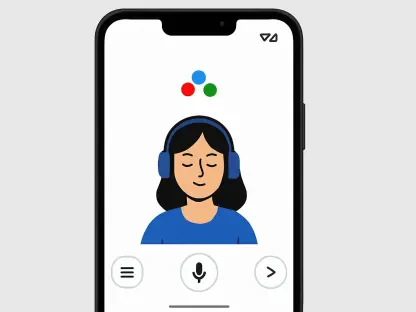In the fast-evolving field of app development, businesses are increasingly aiming to extend their reach across various platforms. Traditionally, mobile app development commanded primary focus, but the burgeoning need for web and desktop applications has shifted paradigms. This swelling demand aims to foster a unified and consistent user experience across all device types. However, the multifaceted challenge lies in developing applications that seamlessly function across all platforms while maintaining high quality, performance, and usability. This is where Flutter, Google’s open-source UI software development kit, comes into play.
Initially celebrated for mobile app development, Flutter has now broadened its horizon to include web and desktop support. This expanded capability allows for creating a single codebase that effortlessly operates on mobile, web, and desktop platforms, streamlining development processes and conserving costs. Such a versatile tool is becoming increasingly vital as audiences demand seamless transitions and experiences across their various devices. The key to Flutter’s impact lies in whether it can indeed revolutionize web and desktop application development in the way it has transformed mobile app creation.
The Rise of Flutter in Cross-Platform Development
Flutter has gained significant traction in the app development community, standing out for its cross-platform capabilities. By enabling developers to use a single codebase for multiple platforms, Flutter substantially reduces development complexity, time, and costs. This is a tremendous advantage for businesses striving for faster time-to-market while maintaining a uniform user experience across mobile, web, and desktop applications. The principle of “write once, run anywhere” is not new, but Flutter makes it notably efficient and practical in the context of modern app development needs.
The rise of Flutter in cross-platform development can be attributed to its ability to balance simplicity and power. Developers can build visually attractive applications that perform excellently across different devices without needing to continually rewrite or adapt code for each platform. This uniformity not only accelerates the development cycle but also ensures that users have a consistent experience, regardless of the device they are using. The result is enhanced overall user satisfaction and a reduction in the resources required for development and maintenance.
Optimized Web Experience with Flutter
Flutter ensures web applications run seamlessly in browsers, retaining a native-like feel irrespective of screen size. Unlike traditional web development frameworks that rely on HTML, CSS, and JavaScript, Flutter’s powerful rendering engine provides a more direct rendering approach. This leads to a noticeable performance improvement, allowing developers to create web applications that perform at native speeds. The framework’s capability to render the UI directly bypasses common performance hitches, thus delivering smooth animations, high-quality graphics, and responsive interfaces crucial for modern web applications.
This optimized web experience holds significant importance for businesses aiming to provide a consistent user experience across all devices. The ability to leverage Flutter’s capabilities means that developers can create high-performance web applications without compromising on speed or quality. As web users increasingly expect fast, seamless, and visually appealing interactions, Flutter offers a key advantage in meeting these expectations. It not only enhances the performance of web applications but also aids in maintaining design uniformity, which is vital for branding and user engagement.
Robust Desktop Application Support
Flutter’s enhanced support extends to major desktop operating systems such as macOS, Windows, and Linux, offering unprecedented flexibility. This versatility allows developers to integrate native UI components and access desktop-specific functionalities like file management and hardware interaction. Such integration is essential for ensuring an optimized, high-quality user experience across all desktop platforms. By allowing for detailed and nuanced control over the desktop environment, Flutter makes it possible to deliver applications that feel truly native to each operating system.
The ability to create high-quality desktop applications with Flutter is a game changer for businesses looking to broaden their reach. Traditionally, developing applications for various desktop platforms would require separate development teams, thereby inflating costs and complicating project timelines. Flutter’s unified approach eliminates this need, enabling businesses to optimize resource utilization and reduce overhead expenses. The streamlined development process offered by Flutter ensures that businesses can efficiently meet the demands of a diverse audience across different desktop environments without compromising quality or performance.
Performance Excellence Across Platforms
Flutter’s custom rendering engine ensures that applications perform at native speeds across all supported platforms, delivering smooth animations, high-quality graphics, and responsive interfaces. Performance consistency is critical for both developers and users, as it allows applications to run efficiently regardless of the device. The widget-based architecture of Flutter guarantees that the design remains uniform across platforms, enabling developers to use the same set of widgets for different device versions. This uniformity enhances user satisfaction by providing a consistent user interface and user experience (UI/UX).
Such performance excellence across platforms is essential in today’s competitive app market. Users are increasingly less tolerant of lag and inconsistencies, expecting their applications to perform flawlessly and look great on any device they use. Flutter’s ability to meet these expectations by utilizing a single codebase translates into a more streamlined and cost-effective development process. Moreover, it ensures that the final product is not just functional but also polished and professional, which is critical for maintaining user engagement and loyalty.
Cost-Effectiveness and Resource Optimization
Utilizing a single codebase for multiple platforms means businesses save on development and maintenance costs. Flutter eliminates the need for separate development teams for each platform version of an application, thereby optimizing resource utilization and reducing overhead expenses. This cost-effectiveness is particularly beneficial for startups and small businesses with limited budgets. By investing in Flutter, they can develop high-quality applications that run seamlessly across mobile, web, and desktop platforms without incurring significant costs.
Streamlining the development process with Flutter allows for better allocation of resources, enabling businesses to focus on innovation and enhancement rather than the repetitive task of coding for multiple platforms. The reduction in man-hours needed for development and subsequent maintenance also leads to quicker release cycles, which is vital in today’s fast-paced digital economy. Furthermore, the economic benefits of using Flutter extend beyond mere savings in development costs, as the platform’s efficiency can lead to a faster market entry, giving businesses a strategic advantage over competitors.
Access to Native Features
Flutter allows developers to leverage native system features across all platforms, including access to device sensors, file systems, and platform-specific APIs. This accessibility is a significant advantage as it enables the creation of applications with rich, immersive user experiences tailored to each platform’s unique capabilities. The ability to access native features ensures that applications can perform a wide range of functions integral to an engaging user experience, from leveraging device hardware to providing seamless integration with other native applications.
This capability is crucial for applications that require access to device-specific functionalities. Developers can harness the full potential of each platform, creating more intricate and sophisticated applications. This feature of Flutter helps bridge the gap between cross-platform convenience and the specialized performance of native platform development. As a result, Flutter-built applications do not just function well across different devices, but also take advantage of each device’s full potential, providing users with an optimized and interactive experience.
Real-World Applications of Flutter
Various prominent companies, including Google, BMW, and eBay, use Flutter to power their applications, demonstrating its effectiveness in real-world scenarios. Google Ads, for example, leverages Flutter to offer cohesive mobile and web app experiences, ensuring a seamless user interface and user experience across different devices. BMW integrates Flutter for consistent in-car applications, highlighting the framework’s capability to deliver reliable and high-performance applications in a demanding environment. Meanwhile, eBay utilizes Flutter’s capabilities across mobile, web, and desktop platforms, ensuring that their vast user base receives a consistent experience.
These real-world applications of Flutter illustrate its efficacy and versatility in delivering high-quality, cross-platform applications. They serve as powerful endorsements of Flutter’s capability to meet the complex demands of modern users. By adopting Flutter, businesses can ensure their applications not only meet but exceed user expectations across various platforms. The successful implementation of Flutter by these major companies underscores the framework’s potential to transform app development practices, making it a viable choice for businesses looking to stay ahead in a competitive market.
Industry Trends Favoring Flutter
The industry trend is increasingly favoring frameworks that enable a unified codebase for diverse platforms, and Flutter epitomizes this trend. By providing tools to bridge mobile, web, and desktop app development, Flutter aligns perfectly with the modern demand for a unified development approach. Ensuring a consistent user experience across platforms has become a priority, with users expecting seamless transitions between devices. This makes frameworks like Flutter highly relevant and increasingly preferred by developers and businesses alike.
The continuous drive for high-performance applications, combined with cost and time efficiency, is evident in the industry’s shift towards comprehensive frameworks like Flutter. Flutter’s custom rendering engine is a crucial element in delivering optimal performance across platforms. By aligning with current trends towards resource optimization and faster market delivery, Flutter provides businesses with the tools necessary to stay competitive and responsive to user needs. The framework’s ability to support a unified development process enhances its appeal, making it a strategic choice for companies aiming to deliver consistent and superior user experiences.
Conclusion
In summary, adopting Flutter has proven to be a smart move for businesses aiming to future-proof their applications. This framework offers robust performance, cost-efficiency, and seamless cross-platform capabilities, enabling businesses to cater to various devices with a single codebase. By hiring skilled Flutter developers, companies can significantly boost their application’s market presence and better align with the ever-evolving demands of modern users.
Flutter isn’t merely a tool for today’s needs but a strategic asset geared for future challenges in app development. Its versatility and efficiency have positioned it as a critical component in forward-thinking development strategies. Companies investing in Flutter can expect sustained relevance and numerous benefits, making it essential for anyone looking to stay ahead in the fast-paced tech environment. This foresight ensures that businesses not only meet current user expectations but are also well-prepared for the technological advancements of tomorrow.
Flutter’s adaptability allows for continuous improvement and innovation, making it a hallmark of advanced application development. Its comprehensive features and potential for long-term benefits underscore why it is becoming an indispensable tool for developers. By choosing to adopt Flutter, businesses secure their path toward future growth and success in an ever-competitive market.









